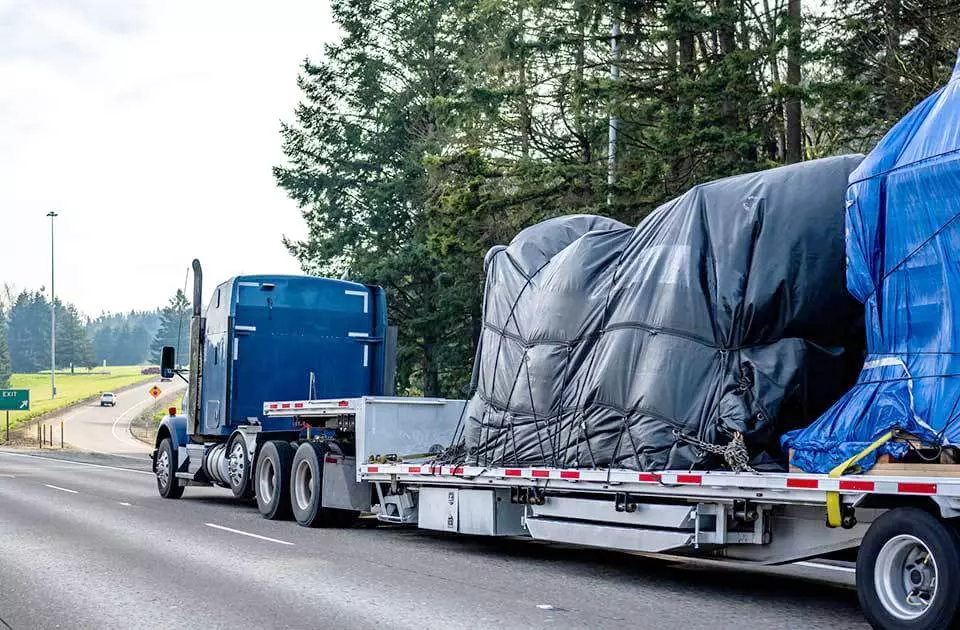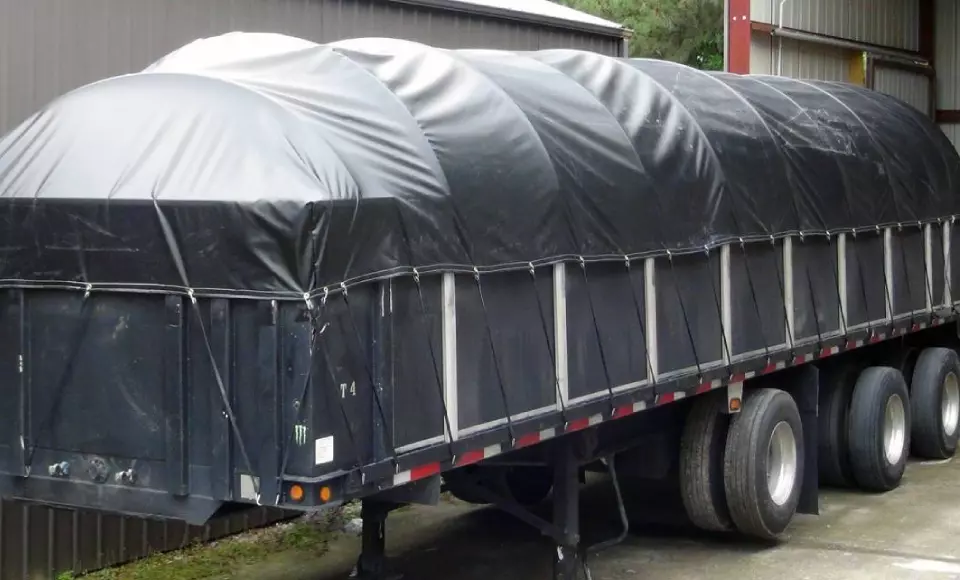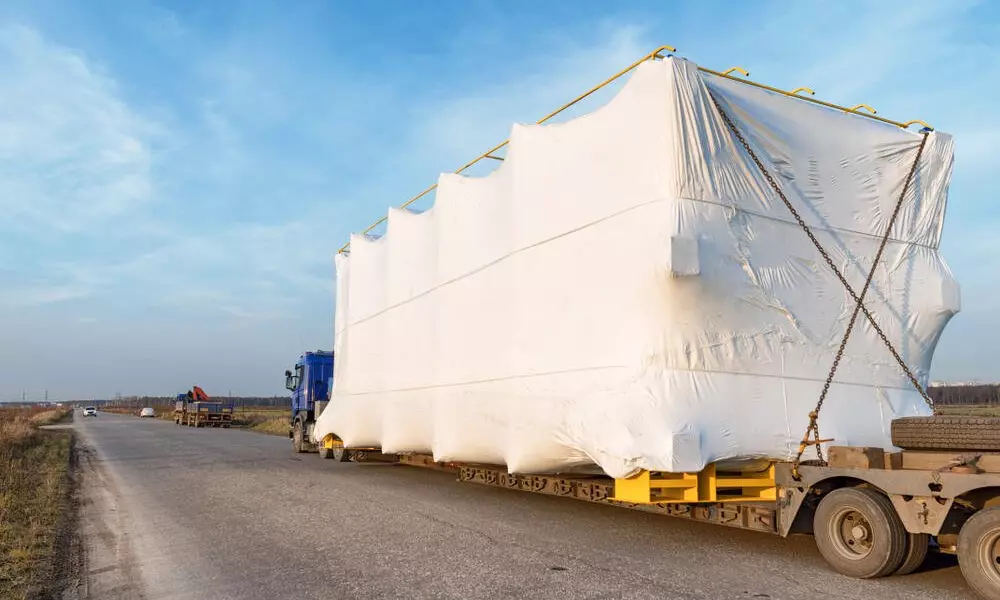Transporting exposed cargo on open-deck trailers, such as step-deck trailers, lowboys, or flatbed trailers, can be challenging and hazardous at the same time. Fortunately, these risks can be easily mitigated using trailer tarps.
Trailer tarps are heavy-duty sheets made from various materials such as vinyl, canvas, or polyethylene, that are designed to cover open trailers. They are manufactured to be durable and also help to secure cargo on trailers.
In this article, we’ll explore the various types of trailer tarps and how to choose the most suitable one. We’ll also cover the costs of these traps and the regulations that each state has in place.
What Is a Trailer Tarp?
A trailer tarp, also known as a truck tarp, trailer cover, or simply tarp, is a large piece of material typically made from vinyl, canvas, or polyurethane. As mentioned earlier, truckers place it onto various types of trailers to protect, stabilize, and secure cargo during transit and storage.

Trailer tarps are typically designed with metal rings for drivers to hook bungee cords, tarp straps, rope, and other tie-downs onto the trailer. They come in various sizes and configurations to fit different types and sizes of trailers, which we will explore further in the following section.
Common Types of Trailer Tarps
As stated earlier, trailer tarps are commonly made of heavy-duty materials such as vinyl, canvas, or polyester. They are often coated with a waterproof and UV-resistant layer before they are cut and sewn together. Let’s take a closer look at the different types of materials used to manufacture tarps.
Vinyl Tarps
These are the most popular options in the trucking industry. They’re easy to produce and relatively inexpensive to procure. Modern options are highly durable and can easily withstand inclement weather like rain, snow, and heat to a certain extent. Some manufacturers coat them with PVC to improve water and UV resistance.
Canvas Tarps
In contrast to vinyl tarps, canvas tarps are made from cotton-blend fabric. As a result, they’re incredibly breathable and ideal for covering machinery, construction equipment, and other loads susceptible to moisture buildup. Canvas tarps are also known for their durability and tear resistance. They are also known to withstand extreme weather conditions without tearing or wearing out.
Polyethylene Tarps
They are the go-to option for truckers and companies with a modest budget. Polyethylene tarps are highly affordable and readily available online and in trucking stores. What sets them apart from other tarps is their weight. Their lightweight nature makes them easy to use and store.
Moreover, their waterproof feature provides effective protection against rain and snow. However, they’re less durable than vinyl tarps unless you buy more expensive PVC-coated options with better weather resistance.
Mesh Tarps
As the name suggests, mesh tarps are made from woven fabric and feature an open weave design that allows air and light to pass through. These trailer tarps are double-stitched to enhance strength and durability, making them tear-resistant.
They’re also UV-resistant and can be used as a fire retardant when transporting flammable cargo. Most truckers use them to transport sand, gravel, debris, and other materials.
Nylon Tarps
Tarps made from synthetic materials like nylon or polyester provide certain benefits. They’re lightweight by nature and resistant to UV rays and mold. While this material is usually used for recreational purposes, it can be convenient for covering cargo that requires less protection as it is easy to handle.
Understanding Tarp Specifications
Truckers need to consider various factors when choosing trailer tarps. Tarp specifications are among the most crucial factors to consider. Many trucker drivers and trucking companies procure multiple tarps for different loads and functions. Below is a brief overview of the key specifications to consider.

Dimensions
Tarp dimensions are the first factor to consider when choosing a tarp. Ideally, you want your tarp to fit your trailer dimensions and accommodate different types and sizes of cargo, including lumber, construction equipment, or machinery.
So, when choosing one for a flatbed, lowboy, or drop-deck trailer, ensure the tarp’s width exceeds the trailer’s width moderately taking into account the additional length for cargo height.
Truckers can procure multiple tarps or an extra large one if transporting tall or oversized cargo frequently. Most tarps range from 16 to 27 feet long to 24 to 27 feet wide.
Weight
Trailer tarps come in different types and weights. Tarps that are heavier may complicate the tarping process, especially when hauling tall loads. Simply put, the heavier the tarp, the higher the safety risks when tarping tall loads. As such, you may require assistance from another person.
In contrast, lightweight traps have their own challenges. While they are easier to handle, they are more susceptible to strong winds during the tarping process. Besides that, they offer less weather protection and may not be as durable as their heavier counterparts.
Hence, they’re ideal for transporting smaller loads in normal weather conditions. Ultimately, choosing between heavy and lightweight trailer tarps depends on your load and weather conditions. Many truckers keep multiple options and interchange them accordingly.
Tie-Down Points
Tie-down points are crucial in securing tarps to trailers and cargo loads during transit. Most trailer tarps have D-rings strategically placed along their length and width as tie-down points, making anchoring them to the trailer or cargo easier.
However, stability depends on the number of tie-down points. The more tie-down points, the better the tension distribution and cargo security. A tarp with more tie-down points will fare better in extreme wind conditions and protect cargo from shifting and potential damage.
Function
Different trap materials serve different functions. For instance, vinyl tarps are highly durable and better protect cargo in inclement weather conditions. Meanwhile, polyethylene traps are incredibly lightweight, making them easier to use. Therefore, choosing the right type of tarp will depend on your cargo’s characteristics and transportation needs.
Automation
Automated tarping systems are among the latest innovations in the trucking industry. They’re designed to simplify and accelerate the tarping process, allowing drivers to save valuable time and energy when transporting goods that require additional protection.
Automated tarping systems also mitigate some safety risks. For instance, truckers no longer have to climb a ladder or on top of the trailer to cover the cargo and risk injuries. They can simply push a button or flip a switch to cover or uncover the cargo from their cabins.
Automated tarping systems have taken off since their inception and are becoming more popular among truckers. They’re available in different sizes and technologies and can cater to various loads and trucking needs.
However, it is important to note that automated tarps function within a fixed-dimension frame. This would potentially limit truckers from hauling oversized or irregularly shaped cargo.
How Much Do Trailer Tarps Cost?
Tarps typically cost between $200 to $1,200, depending on the material, size, and manufacturer. Below, you’ll find a list of average prices from different manufacturers that we’ve researched.
- Vinyl Tarp Prices: between $200 to $800
- Canvas Tarp Prices: between $300 to $1,200
- Polyethylene Tarp Prices: between $200 to $700
- Mesh Tarp Prices: between $300 to $800
- Nylon Tarp Prices: between $300 to $900
Tarping Requirements by Truck Class
Tarping regulations apply to all utility trailers and truck classes from Class 3 to 9, in the United States. Below is a brief description of these truck classes for further reference.
- Class 3 & 4 Light to Medium-Duty Truck
- Class 5 & 6 Medium-Duty Trucks
- Class 7 & 8 Heavy-Duty Truck
- Class 8 Heavy-Duty Truck
- Class 9 Super-Heavy Truck
- Utility Trailers
Tarping a Trailer
Tarping a trailer is a manual (often labor-intensive) process. Truckers must park their truck or trailer on a level surface in ideal weather conditions, place the tarp, and tie it down to ensure security. Feel free to check our complete guide on how to tarp a trailer safely and effectively.
Tarping Regulations by State
It’s important to note that tarping regulations vary by state. Many states mandate truckers to contain or confine loads during highway transit to improve road safety and prevent falling cargo.

Therefore, you should always check with state requirements regularly for the latest amendments, changes, or modifications. The table below shows which US states require tarping and which ones do not. Please note that the table below only serves as a reference and it’s best to check this with your local Department of Transportation (DOT).
| State | Tarp Requirement |
|---|---|
| Alabama | No |
| Alaska | Yes |
| Arizona | Yes |
| Arkansas | No |
| California | Yes |
| Colorado | Yes |
| Connecticut | Yes |
| Delaware | No |
| Florida | Yes |
| Georgia | Yes |
| Hawaii | Yes |
| Idaho | Yes |
| Illinois | No |
| Indiana | No |
| Iowa | Yes |
| Kansas | Yes |
| Kentucky | Yes |
| Louisiana | No |
| Maine | No |
| Maryland | Yes |
| Massachusetts | Yes |
| Michigan | Yes |
| Minnesota | Yes |
| Mississippi | Yes |
| Missouri | Yes |
| Montana | Yes |
| Nebraska | Yes |
| Nevada | Yes |
| New Hampshire | Yes |
| New Jersey | No |
| New Mexico | Yes |
| New York | Yes |
| North Carolina | Yes |
| North Dakota | Yes |
| Ohio | Yes |
| Oklahoma | No |
| Oregon | No |
| Pennsylvania | Yes |
| Rhode Island | Yes |
| South Carolina | Yes |
| South Dakota | Yes |
| Tennessee | Yes |
| Texas | Yes |
| Utah | Yes |
| Vermont | Yes |
| Virginia | Yes |
| Washington | Yes |
| West Virginia | Yes |
| Wisconsin | No |
| Wyoming | No |

Get Free Course Access
If you enjoyed the article, don’t miss out on our free supply chain courses that help you stay ahead in your industry.

Andrew Lin
Co-Founder & Writer
at freightcourse
About the Author
Andrew is a multi-business owner with over 12 years of experience in the fields of logistics, trucking, manufacturing, operations, training, and education.
Being the co-founder of freightcourse has given him the ability to pursue his desire to educate others on manufacturing and supply chain topics.
Follow us